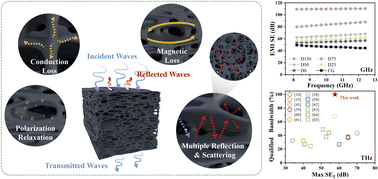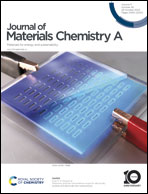An artificially re-structured PEDOT:PSS/konjac glucomannan sponge toward high-performance electromagnetic interference shielding from gigahertz to terahertz bands†
Abstract
The entire world has been reshaped with the development of wireless communication. From present to future, 5G to 6G, gigahertz (GHz) to terahertz (THz), electromagnetic waves with higher frequency penetrate our daily life more intensively and are increasingly expected to do so in the future. Thus, a huge demand has arisen for future electromagnetic interference (EMI) shielding materials. Herein, we report a facile approach to prepare sponges from PEDOT:PSS and konjac glucomannan (KGM) revealing excellent EMI shielding performance in both GHz and THz bands. The cross-linked bi-hierarchically porous microstructure dominated by the dimethyl sulfoxide ratio with tunable hydrogen-bond behavior possesses a complicated air interface with highly polarization relaxation and massive conductive loops with negative permeability, resulting in great dielectric loss and magnetic loss with no magnetic filler, respectively. As a result, the purely organic sponge shows an ultra-high average EMI shielding effectiveness (SE) of 109.84 dB in the GHz band (8.2–12.4 GHz), and an ultra-broad qualified frequency bandwidth of 0.2–4 THz with maximum EMI SE in 57.67 dB. The combined contributions of solvent modulated pure organic sponge with multiple shielding mechanisms are conducive to facilitating the development of ultra-broadband EMI shielding materials.



 Please wait while we load your content...
Please wait while we load your content...